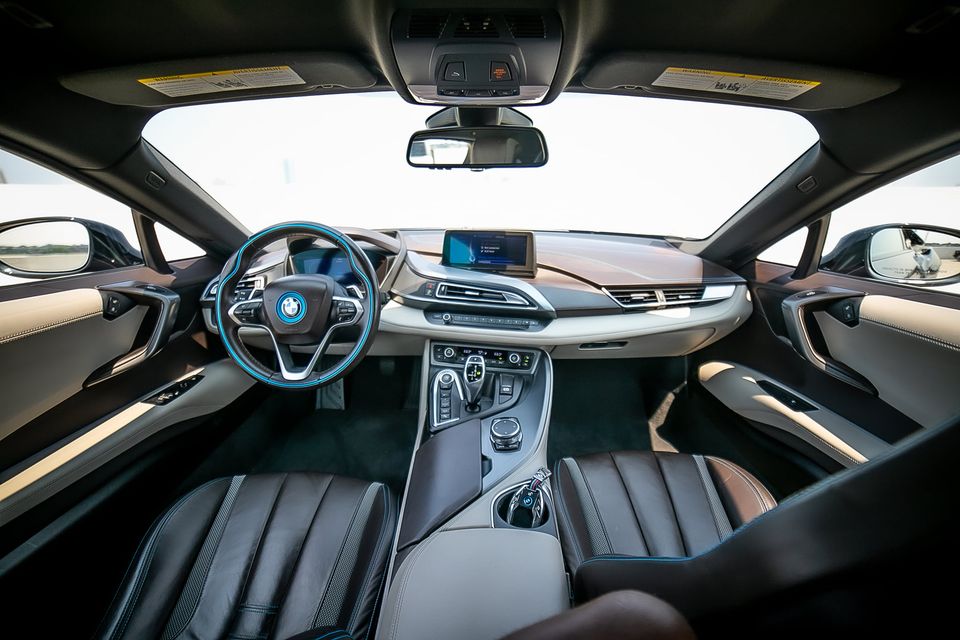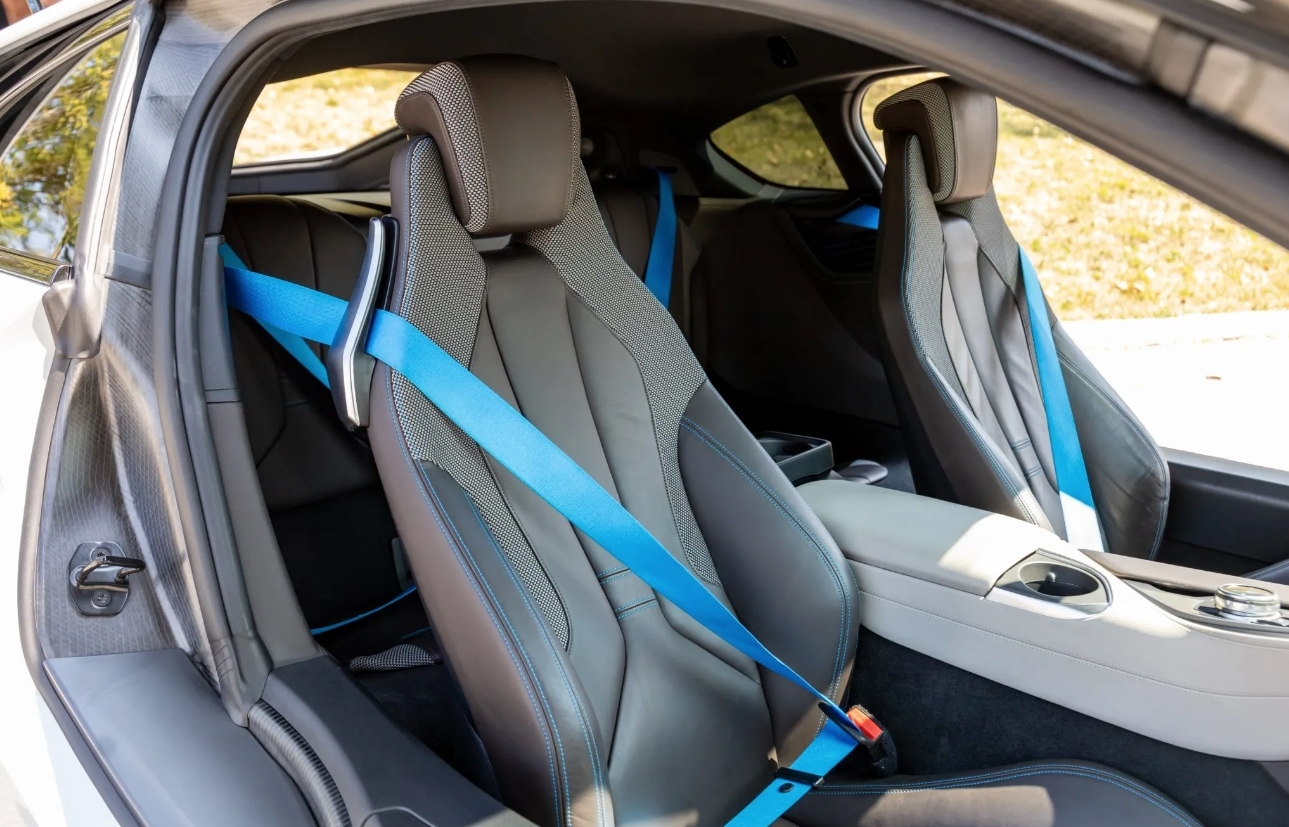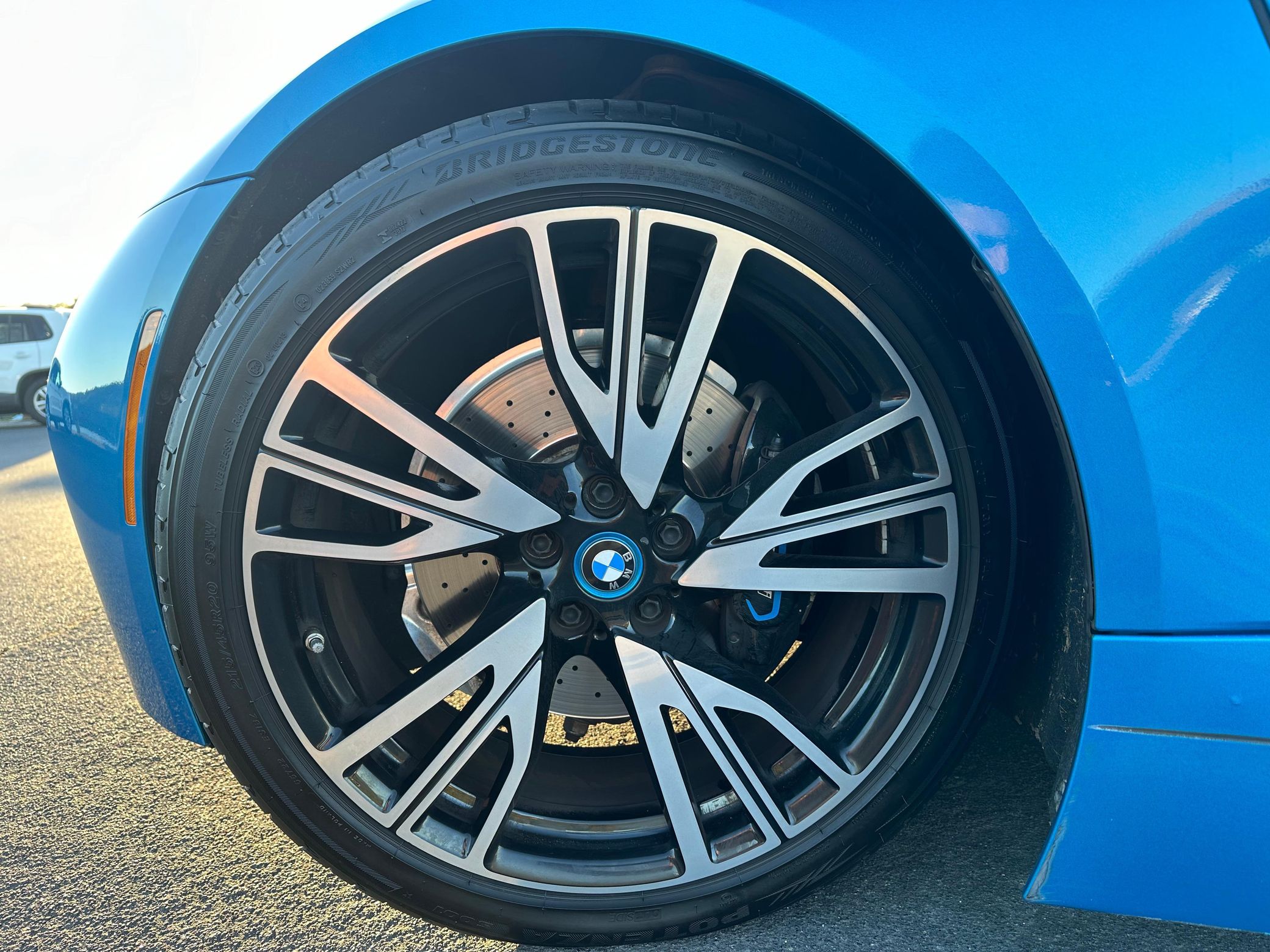When the BMW i8 was first introduced in 2014, it represented a groundbreaking moment for BMW, it was eco-conscious engineering with the idea of a sports car. As part of BMW’s visionary "i" sub-brand, the i8 was more than just a new model; it was for the future of hybrid mobility, where performance and sustainability could coexist harmoniously.
Tasked with reshaping perceptions of what a modern hybrid sports car could be, the i8 merged electric technology with BMW’s traditional commitment to driving pleasure, wrapped in a futuristic design.
Under the sculpted hood of the BMW i8 lies an innovative powertrain: a turbocharged 1.5-liter three-cylinder gasoline engine paired with an electric motor, producing a combined output of 357 hp in its initial version, later boosted to 369 hp.
This combination allowed the i8 to accelerate from 0 to 60 mph in just 4.2 seconds, proving that eco-friendly didn't mean slow. The car also featured an electric-only range of up to 23 miles in its early versions, expanded to 33 miles after the 2018 update.
The exterior of the i8 was unmistakably futuristic, with sleek lines, a low-slung profile, and scissor doors that opened dramatically upward, setting it apart from any other sports car on the road.
Its aerodynamic design was not just for show—the i8's flowing shape, complemented by air curtains, vents, and diffusers, optimized airflow, and minimized drag. The extensive use of carbon fiber reinforced plastic (CFRP) in the body helped reduce weight and improve efficiency, ensuring that the i8 performed as dynamically as it looked.
Inside, the i8 cabin is filled with futuristic touches, from the fully digital instrument panel to the use of recycled materials. The seats were supportive yet comfortable, with a minimalist design that reflected the car's high-tech nature. Meanwhile, BMW's iDrive system provided control of navigation, media, and vehicle settings.
Throughout its production years, the BMW i8 faced competition from rivals like the Acura NSX and the Porsche 911. However, the i8 stood out with its forward-thinking hybrid technology, innovative design, and unique driving experience, appealing to those who valued not just speed, but a glimpse into the future of automotive engineering.
Model Changes (Breakdown by Year)
2014 BMW i8
The BMW i8 was introduced in 2014 as part of BMW's "i" sub-brand, showcasing the future of hybrid sports cars. Powered by a 1.5-liter turbocharged three-cylinder engine paired with an electric motor, the i8 delivered 357 hp with a focus on both performance and efficiency. Its design was equally striking, featuring scissor doors, a sleek aerodynamic body, and a lightweight carbon fiber structure.
The starting price for the 2014 BMW i8 was approximately $135,700.
2015 BMW i8
In 2015, the BMW i8 saw no significant changes, as it was the model’s first full year of production.
The starting price for the 2015 BMW i8 was approximately $136,500.
2016 BMW i8
In 2016, the BMW i8 received a few minor updates. A software update improved the precision of energy management between the electric motor and the gasoline engine, optimizing the hybrid system's efficiency. This allowed for smoother transitions between the two power sources and improved driving dynamics.
BMW also expanded customization options by introducing new interior and exterior colors. Buyers could now choose from new exterior shades like Protonic Blue and Crystal White, while interior options featured additional combinations of leather and trim, allowing for more personalized finishes.
Also, the brand launched special editions, including the Protonic Red Edition, which featured an exclusive red exterior with Frozen Grey accents and unique interior details.
The starting price for the 2016 BMW i8 was approximately $140,700.
2017 BMW i8
In 2017, BMW introduced the i8 Protonic Red Edition.
This edition featured a bold Protonic Red exterior paint, complemented by Frozen Grey accents that enhanced the car's futuristic look.
Special badging further set this model apart from the standard i8. Inside, the Protonic Red Edition continued its exclusive theme with bespoke interior trims, including red stitching and carbon fiber detailing.
The starting price for the 2017 BMW i8 was approximately $143,400.
2018 BMW i8
In 2018, BMW introduced the i8 Roadster, a convertible variant of the i8. The Roadster featured a soft-top roof that could open or close in about 16 seconds at speeds up to 31 mph, providing the thrill of open-air driving while maintaining the i8's design. The Roadster utilized the same hybrid powertrain as the coupe but with an updated battery capacity, which improved the electric-only range.
The electric range was increased to 33 miles, offering more versatility for everyday driving. However, the Roadster was slightly heavier than the coupe, which resulted in a slightly slower 0-60 mph time of 4.4 seconds.
Alongside the introduction of the Roadster, the i8 Coupe received a significant refresh. This included a larger battery pack, increasing its capacity from 7.1 kWh to 11.6 kWh, which brought its electric range in line with the Roadster at 33 miles. Power output for both models was increased to a combined 369 hp.
Inside, the 2018 updates also brought refined materials and new options to the interior, such as ceramic controls, and new seat design.
The starting price for the 2018 BMW i8 Coupe was approximately $147,500, while the newly introduced i8 Roadster started at around $163,300.
2019 BMW i8
In 2019, BMW introduced the i8 Ultimate Sophisto Edition, a limited-run model. This edition came with Sophisto Grey exterior paint, which was complemented by striking E-Copper accents and unique 20-inch bespoke alloy wheels.
Mechanically, the Ultimate Sophisto Edition did not bring any major changes. The performance and powertrain remained the same as the previous year.
The starting price for the 2019 BMW i8 Coupe was approximately $148,500, while the i8 Roadster had a starting price around $164,300.
2020 BMW i8
In 2020, BMW announced that it would be the final year of production for the i8. The last units of the i8 were part of a special final production run in March 2020; the conclusion of its six-year journey.
There were not many changes or updates for the final year of the i8.
The starting price for the 2020 BMW i8 Coupe was approximately $147,500, while the i8 Roadster started at around $163,300.
BMW i8 Common Problems
The BMW i8, despite being a groundbreaking hybrid sports car, has faced a handful of common issues over the years. While most owners enjoy their i8s, some have experienced recurring problems that can affect reliability and driving satisfaction. Below are some of the most common issues that i8 owners have encountered, ranging from engine concerns to suspension and build quality problems.
Keep in mind, that it is essential that all cars, even supercars, can have issues and it is crucial to perform a Pre-Purchase Inspection (PPI) from an authorized dealer or experienced independent mechanic to reveal all issues.
Electrical Issues: A significant number of BMW i8 owners have reported electrical problems, particularly related to the high-voltage battery. These issues can cause warning lights to appear on the dashboard and affect multiple systems such as the infotainment, air conditioning, and power windows.
Fuel Leaks: Early models of the BMW i8, particularly those from 2014, were subject to a recall due to fuel leaks caused by an improperly welded bolt that attached the fuel tank to the chassis. This issue was rectified, but it's worth checking if the recall work was performed on older models.
Large Butterfly Doors: While the i8's scissor doors are a stylish feature, they can be problematic in tight parking spaces. These large doors require ample room to open fully, which can make them inconvenient in public parking lots.
Engine Overheating: Some BMW i8 owners have reported issues with engine overheating, often caused by a faulty thermostat, a coolant leak, or a failed radiator. If left unchecked, this can cause serious damage to the engine.
Airbag and Seatbelt Issues: After an accident, some i8 models have experienced problems with airbags and seatbelts, particularly if the airbag module codes are not reset. This can lead to issues with airbags not deploying correctly or seatbelts locking up.
Faulty Sensors: The coolant temperature sensor is known to fail in some BMW i8 models. A malfunctioning sensor can lead to poor engine performance or overheating, as the sensor is responsible for regulating coolant flow.
Recalls
2020 BMW i8 vehicles
Electrical system: Propulsion system: Traction battery (Recall no. 20V601000)
Debris may have entered one or more of the hybrid battery cells during their production. The debris could result in a short-circuit, increasing the risk of fire or injury.
2019 BMW i8 vehicles
Electrical system (Recall no. 19V599000)
A circuit board problem within the Electric Motor Electronics (EME) module may shut down the supply of high-voltage electrical power. A shut down of high-voltage electrical power would result in a loss of propulsion, increasing the risk of a crash.
2019 BMW i8 and i8 Roadster vehicles
Equipment: Electrical (Recall no. 18V652000)
Capacitors within the TurboCord Portable Chargers may fail, possibly resulting in a shock hazard or a fire. An electrical shock or a fire can increase the risk of injury or death.
2017 BMW i8 vehicles
Air bags (Recall no. 16V914000)
The affected vehicles have seat-mounted side air bag inflator initiators that may fail to ignite during a crash. If the air bag inflator initiator fails to ignite, the seat-mounted air bag will not deploy, increasing the risk of injury.
2015 BMW i8 vehicles manufactured May 29, 2015, to June 5, 2015.
Electronic stability control (esc) (Recall no. 15V882000)
Improperly drilled holes within the Dynamic Stability Control (DSC) hydraulic unit may restrict one or more pistons impairing the DSC functions, including braking. Impaired DSC functionality may negatively impact vehicle handling and braking and increase the risk of a crash.
2014 BMW i8 vehicles manufactured from May 16, 2014, to September 16, 2014.
Fuel system, gasoline: Storage: Auxillary tank (Recall no. 14V674000)
A bolt used to attach a ground cable between the tank and the vehicle chassis may not have been properly welded during manufacturing. An inadequate weld of the bolt to the fuel tank could cause a fuel leak. In the presence of an ignition source, a fuel leak could lead to a fire.
Maintenance and Ownership Costs
Compared to other hybrid sports cars, the BMW i8 is considered relatively affordable in terms of maintenance. However, owning an i8 still comes with notable costs due to its advanced hybrid system and the use of unique components like the high-voltage battery. Routine maintenance such as oil changes, brake service, and tire replacements can be more expensive than typical vehicles, especially if performed at a BMW dealership.
However, it is important to remember that regular maintenance and repairs will still be necessary, and the costs can vary depending on whether you take your car to a dealer or an independent mechanic.
Here are the suggested service schedule and intervals per BMW:
Every 5,000 and 10,000 Miles
Oil change with filter
Check brakes
Check indicator light
Check rubber belts & hoses
Check engine coolant
Check steering linkage
Check suspension components
Check for fluid leaks
Check wipers and wiper fluid
Check tire pressure
Check dashboard warning lights
Check horn
30,000 / 90,000 / 150,000 Miles (BMW Inspection 1)
Includes all Oil & Safety Service checks
Verify engine temperature
Check condition of brake fluid
Check transfer case and differential fluids
Inspect cooling system for leaks
Complete inspection of steering and suspension components
Inspect exhaust system (leaks, positioning, mounting)
Clean brake pad contact points
Check brake disc surfaces
Check brake pad thickness
Inspect brake lines and clutch system (for leaks, damage, positioning)
Check position and movement of parking brake cables
60,000 / 120,000 Miles (BMW Inspection 2)
Includes all Oil & Safety and Inspection 1 checks
Check parking brake lining
Replace spark plugs
Replace air filters
Check flexible boots for leaks
Check car body for rust under rust prevention warranty
Here is a rough estimate of typical service costs associated with the BMW i8:
Oil Change - On average, a BMW i8 oil change costs between $138 and $250, depending on whether it's done at a dealership or an independent shop. This service is required every 10,000 miles.
Minor Service - Minor services, including checks and replacements of filters and fluids, typically range from $500 to $750 depending on the service center. This type of service includes inspections of various systems, like brakes and suspension, as well as fluid top-offs.
Major Service - Major services, which involve comprehensive inspections, spark plug replacements, and possibly brake fluid changes, can cost between $1,500 and $3,000. This is generally done at 30,000, 60,000, and 90,000-mile intervals.
Tires - Replacing all four tires on the BMW i8 can cost around $1,200 to $2,000, depending on the brand and type of tires chosen. Given the i8’s high-performance specifications, premium tires are recommended such as Michelin Pilot Super Sport tires.
Battery - If for any reason your battery goes, you will be shelling out around $5,000 to $7,000 for one to go into your car.
Brakes - Replacing the brake pads and rotors can cost between $1,500 and $2,500. This service may be needed at different intervals depending on driving habits.
Clutch - Though the BMW i8 is a hybrid with an automatic transmission, in rare cases of transmission work or dual-clutch system replacement, costs can range up to $5,000, though such repairs are relatively uncommon.
Options List
When it comes to purchasing a BMW i8, there are a few options to consider.
The options for the i8 can be broken down into a few key categories:
For the exterior, buyers can select from several exclusive paint colors, such as Protonic Blue Metallic and Crystal White Pearl Metallic. The i8 also offers optional laser headlights, which provide brighter and more efficient lighting compared to the standard LED headlights.
The i8's distinctive design can be further personalized with optional 20-inch wheels.
When it came to the interior, there were a few options that focused on premium materials. The i8 can be outfitted with ceramic controls and leather upholstery in shades like Amido Black or Dalbergia Brown, which add an extra layer of luxury.
Optional Harman Kardon surround sound enhances the in-car audio experience, while BMW’s Head-Up Display offers a more intuitive way for drivers to access key information like speed and navigation without taking their eyes off the road.
Performance-wise, the Tera World package provides upgraded materials and trim details, including full leather seats and specific interior stitching. While the i8 is already known for its blend of efficiency and performance, these options further elevate the driving experience.
2014 BMW i8 Options List
Key Options
Tera World Package
Harman Kardon Surround Sound
Laser Headlights
Ceramic Controls
BMW i8 Price and Values
The Best BMW i8 to Buy
When it comes to choosing the best BMW i8, there are several factors to consider.
For those looking for the most refined and feature-packed version, the 2019 BMW i8 is the one to go for. As one of the final years of production, the 2019 model benefits from incremental updates made throughout the i8's lifespan, including a larger battery for extended electric range and improved overall performance.
Additionally, this model year offered the Ultimate Sophisto Edition, which features exclusive paint options, and bespoke interior trims.
Targeting a limited-edition model like the Protonic Red Edition or the Ultimate Sophisto Edition can also offer something different if you don’t want your i8 to be like any others.
For market stability, go for model years 2015 to 2019 to ensure that you won’t lose much money on your i8.
In addition to model selection, the condition and mileage of the i8 should be carefully considered. Well-maintained vehicles with lower mileage are more likely to retain their value and provide a reliable ownership experience.
Thorough research, including service history and any potential recalls (such as early fuel tank issues), is crucial when evaluating an i8 for purchase.
Conclusion
In summary, with a starting price of around $60,000+, the BMW i8 offers a unique combination of hybrid efficiency and sports car performance. Its futuristic design, advanced technology, and eco-friendly powertrain set it apart in the luxury sports car market.
While there are alternatives like the Acura NSX, and the Porsche 911, the BMW i8 distinguishes itself with its innovative plug-in hybrid system and striking forward-thinking aesthetics.
It delivers a smooth blend of electric driving capability and gasoline-powered performance, making it an excellent option for those who value both sustainability and style.
Car Hacking Shortcuts
- Opt for Harman Kardon Surround sound.
- 2015 to 2019 model years for market stability.
Prioritize well-maintained models with full-service history and low mileage.



















